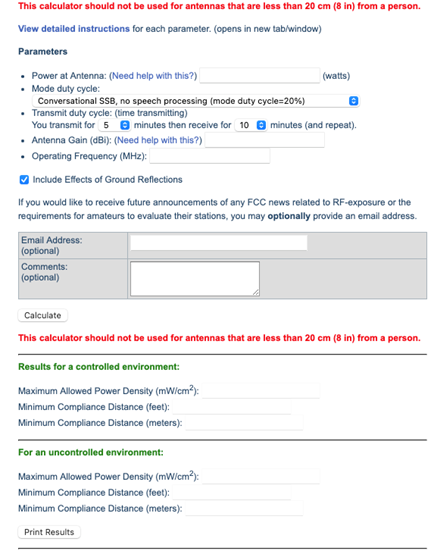Did you know that the Federal Communications Commission (FCC) now requires all amateur radio stations in the U.S. and possessions to be evaluated for RF exposure? It’s been a little more than a year since this went into effect, so OnAllBands thought it would be a good time to remind our readers.
As of May 3, 2023 (the end of a two-year transition period), all transmitters operating in the U.S. were expected to comply with the exposure rules. The new rules did not change exposure limits, but those who were previously exempt from running exposure calculations now must comply.
Under the old rules, many amateurs were exempt from the need to do an evaluation—based on transmitter power used with each band, for example. Under the new rules, there are no longer any service-specific exemptions. These have been replaced with formulas that can be used to determine whether an installation needs to be evaluated.
The ARRL noted that these formulas can be used for exposure that is beyond the near-field/far-field boundary of your antenna, defined as wavelength/2π or 0.16 wavelength. Most stations that were exempt under the old rules will still be exempt from needing to perform a more complete evaluation under the new rules.
As OnAllBands reported last year:
“Under the updated FCC rules, every radio amateur is responsible for determining that their station does not cause exposure that exceeds the FCC MPE (Maximum Permissible Exposure) limits to any person, either within their homes or outside of them. This is also required for portable and mobile operations.”
Gregory Lapin, N9GL, QST Magazine, May 2023
Lapin noted that the FCC does not require that the results of a station’s exposure analysis be submitted, but “it is advisable to keep a record of the analysis so that if there’s ever an exposure complaint about that station, the calculations can be shown to the FCC.”
You can read N9GL’s entire QST article here.
There are many resources on the internet for calculating this RF exposure. The ARRL’s website includes an RF Exposure Calculator (below) to assist amateurs in performing station assessments.

The ARRL points out three ways to evaluate your station: calculations (using the above calculator, for example); antenna modeling; and measurements using calibrated equipment. You’ll find many more details about these methods and additional information in the ARRL document, Frequently Asked Questions about the FCC RF Exposure Rule Changes
We also highly suggest reading these resources recommended by the ARRL:
- 100th Edition ARRL Handbook’s RF Safety Section
- Helping Amateurs Interact with Neighbors Asking about Radio Transmissions
- ARRL Learning Network Video on RF Exposure
Also check out these FCC resources on RF exposure
- FCC Frequently Asked RF Exposure Questions
- FCC Radio Frequency Safety
- FCC Q & A about Biological Effects and Potential Hazards of Radio Frequency Electromagnetic Fields
Questions? Share them in the comments below or email me at KE8FMJ@gmail.com.

